Monolith by Monoprice Belt Drive Turntable Review
Ok, kids, let’s do some word association! Water – Wet. Sky – Blue. Turntable – Monolith by Monoprice. Ummm, what? No, you heard me correctly. Monolith by Monoprice has announced they are getting into the turntable market. So what am I to do? The obvious choice is a review of their Monolith by Monoprice Belt Drive Turntable. Duh!
Offered in two tiers, with two choices of Audio-Technica cartridges and two available finishes, the Monolith by Monoprice Belt Drive Turntable has set itself to be a disrupter in a very audiophile centric market segment. Following Monoprice fashion, they are high-quality, feature-rich, and low-cost units. Priced at $199 and $249, they are solidly in the budget category. But don’t judge these turntables by their prices!
The Monolith by Monoprice Belt Drive Turntable appeals to someone like me. I am looking to get into vinyl, but I have no desire to go down the vinyl rabbit hole right now. However, this is the type of turntable that can grow with you. But more on that later.
| Pros | Cons |
|---|---|
| – Solid construction – Carbon fiber tonearm – Good entry-level stylus – Numerous connection options – Built-in phono preamp – Competitive price | – The lack of adjustable legs makes leveling harder – Output from the turntable is low on the line out and preamp settings – Included cartridge tends to be bass-forward |
Under The Hood
The Monolith By Monoprice Belt Drive turntables come in two models. Both platforms share the same platter, tonearm, drive, and connections. The $199 version comes in gloss black only, while the $249 version gets offered in gloss black and matte walnut. The main difference? The cartridge.
Tonearm
Both models feature the same carbon fiber tonearm. Carbon fiber provides a very lightweight and rigid material to ensure a vibration-free connection to your cartridge, leading to a solid connection to your vinyl. The tonearm comes equipped with both a counterweight and anti-skating adjustments, allowing you to precisely dial in your cartridge and tonearm vertical and lateral tracking force and reduce wear on your cartridge and vinyl.
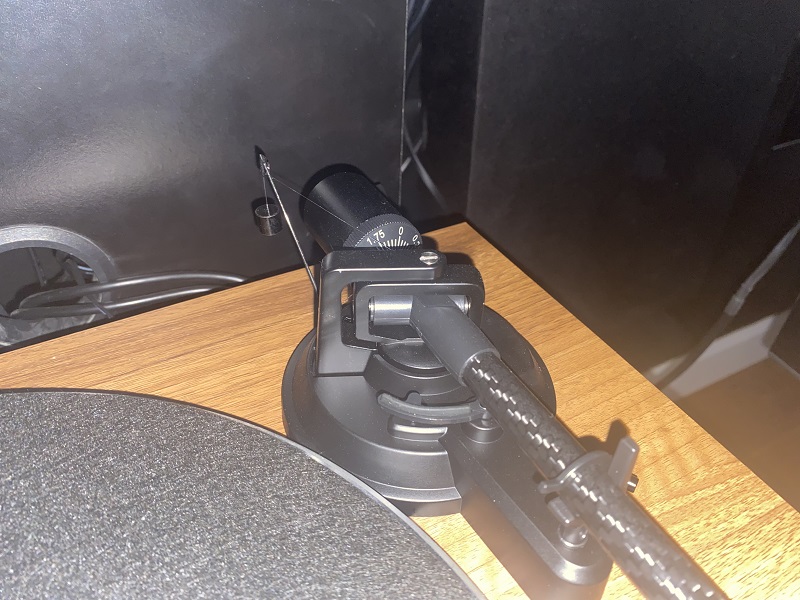
Many high-end turntables have moved away from aluminum tonearms and have moved to carbon fiber. Carbon fiber is generally more challenging to work with and more expensive than its aluminum or acrylic counterparts. Like their Monolith subwoofer, Monoprice caters to the budget-minded but adds premium parts. I still scratch my head at how Monoprice offers these turntables at this price.

Lastly, the tonearm uses a bayonet-style mount for the cartridge. This means that you can easily swap out headshells if you want to change cartridges. This probably won’t matter to a lot of people, but I want to start to experiment with other cartridges to see if I can hear differences. So this will allow me to swap it out in seconds, and then I just have to reset my balance and tracking force.
Cartridge
My Monolith by Monoprice Belt Driven Turntable is equipped with the Audio-Technica AT-VM95E elliptical cartridge. The headshell is removable (see above), so if I decide to change out cartridges, it will be a snap later on. And if I choose to be extra and want to preinstall different cartridges on new headshells, I can swap them out on the fly!
The Audio-Technica AT-VM95E elliptical cartridge is by no means a budget killer. Retailing around $69, it’s a step up from the AT-3600L on the base model turntable. The AT-VM95E will likely have to be replaced more frequently because of the wear and tear associated with elliptical cartridges.
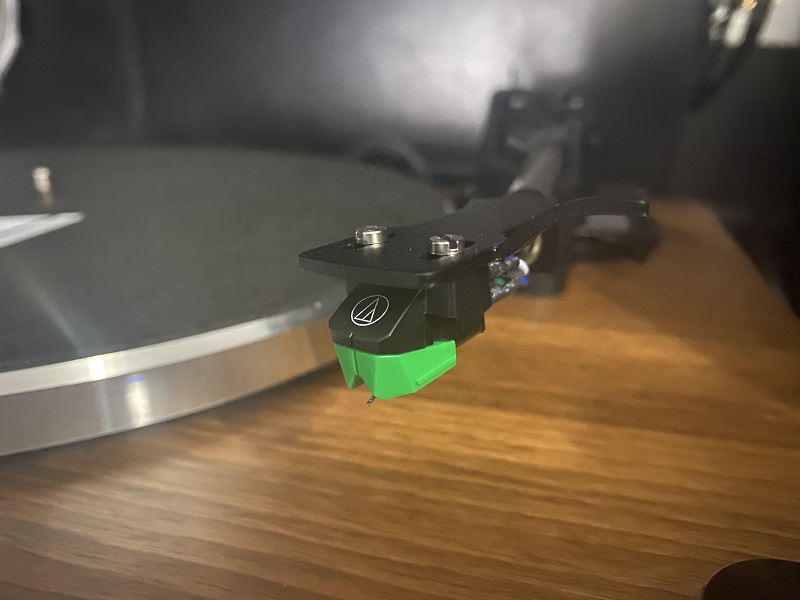
It’s a moving magnet cartridge, so the phono stage in your AV receiver or integrated amp should be able to handle the cartridge with no issues. But, if you don’t have a phono stage, no worries! Monoprice has added a phono preamp. I mean, what budget turntable doesn’t!
I won’t get into the debate about conical vs. elliptical styluses. The TL;DR version is that conical doesn’t sit as deeply into the record’s groove, so they tend to last longer and need less cleaning. Plus, conical styluses are more forgiving on damaged or worn vinyl. So elliptical styluses sit further into the groove of the record and, because of that, are more prone to wear. The trade-off is that the stylus (supposedly) reads more from the record’s groove and will give a cleaner and richer sound. With the ability to swap out the cartridge, you can try both out for yourself and make your own decision. It’ll just cost you a little extra.
Plinth/Platter/Motor/Controls
The build quality for the Monolith by Monoprice Belt Driven Turntable is simple but solid. The plinth is rigid and resonance-free. This rigidity means that it will absorb and dissipate any unwanted vibrations from the motor. The plinth sits atop three solid legs that get finished with a rubber pad to help absorb vibrations from beneath. Here comes one of my minor knit-picks. I wish that the legs were adjustable. My rack is slightly off level, so I have to prop up one side to get the plinth perfectly level. Adjustable legs would have made this easier. Or I could stop being lazy and level my entire rack like I should have done years ago.
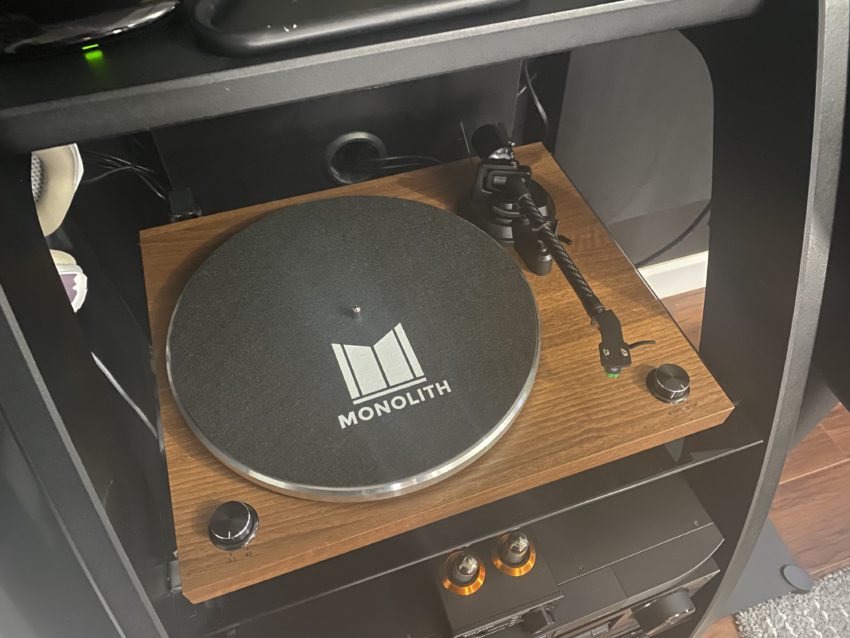
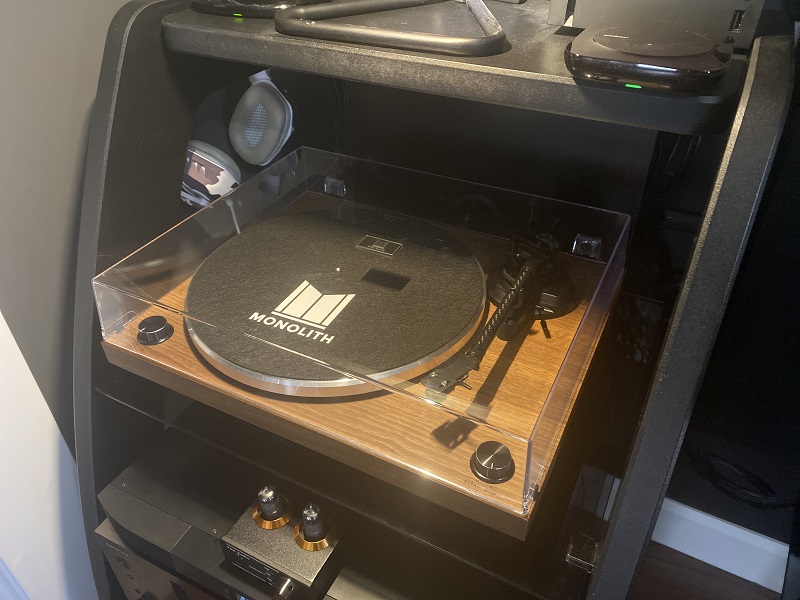
The platter is die-cast aluminum, so it is light and rigid. The motor is very smooth and quiet. The platter spins up quickly when turned on and remains smooth during playback. The connection from the platter to the drivewheel is via a belt, and it too is smooth and resonance/wobble-free.
Monoprice tops the platter with a black felt slipmat, adorned only with a silk-screened white Monolith logo. I totally dig the minimalistic take here. But if I am being honest, I would have preferred that Monoprice opted for either a rubber or cork slipmat to reduce static. It’s not a deal-breaker, but a carbon-fiber brush is a must-have due to the static produced by the felt.
Controls are equally as straightforward. To the left is a speed control for 33 1/3 and 45 RPM. The right side has the on/off knob. There is a small tonearm lift lever to raise and lower your stylus safely.
Connections / Back Side
So again, I will point out my confusion that this budget Monolith by Monoprice Belt Driven Turntable has so many connection options. First, we have RCA outputs with a grounding terminal. This option will enable you to use the built-in phono preamp in your AV/stereo/integrated receiver/amp. I ended up installing a grounding wire to eliminate a ground-loop hum that I started to get. I don’t know if this is common with this turntable, or if it was something in my setup, but I was glad to have a grounding terminal available to me.
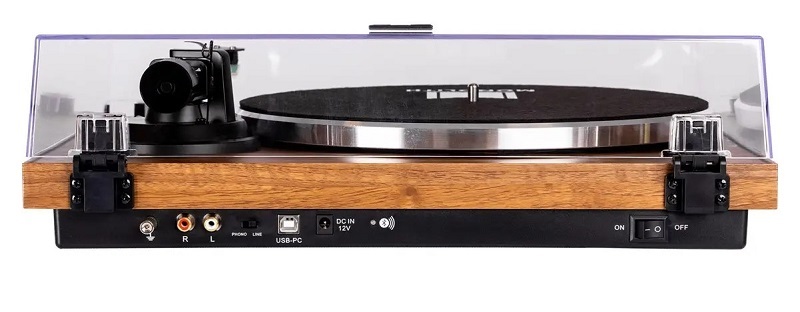
But if you don’t have a phono input on your receiver, no worries. Monoprice has included a phono preamp on this bad boy. Just flip a switch, plug it into your choice input, and you are off to the races. I love that Monoprice has decided to add a preamp to this turntable. It truly makes it a solid choice for beginners who want a quality turntable but on a budget. I did find that the output on their preamp was a bit on the low side, but it would be easy to add a new cartridge with a bit more oomph or a preamp with some extra gain. So I purchased a Fosi X2 preamp (review to come), and I was delighted with the additional output it gave my Monolith Turntable.
A Bluetooth connection option is available, allowing you to connect wirelessly to various sources or speakers, making this a very versatile turntable. Pairing is a snap. Turn on your Bluetooth device and put it in pairing mode. Turn on your turntable with the primary power switch on the backside, and it will go into pairing mode. The LED on the back will flash and then turn solid when it makes a connection. I tried it with my Bluetooth speaker and headphones, and I can report that it was as simple as I made it sound.
But wait, what if I want to rip my vinyl records to my computer? I guess I will have to get an external box or cables to connect my Monolith Turntable to my laptop? Wrong. Of course, this “budget” turntable is equipped with a USB out for ripping your collection! And it’s straightforward. Connect your turntable with the included USB, download a free recording software like Audacity, select the turntable in Audacity, and hit record.
Setup
Setup only takes a few moments. Once I had the turntable out of the box, leveled on my stand, I installed the platter and connected the drive belt. Then, I installed the tonearm counterweight and balanced it. Next, I set the two grams of tracking force recommended for the AT-VM95E cartridge and double-checked with my stylus force gauge. The last step was to install the anti-skate weight at the two-gram position. Then, install the cover on the hinges and grab some vinyl!
I know that sounds uncomplicated, and it is. But that’s part of the fun of vinyl! The Monolith by Monoprice Belt Driven Turntable was probably the easiest turntable I have set up. So if you want to make it more complicated than it should be, there are many 300 step-up guides on YouTube, so you feel like a true audiophile.
Equipment
Ok, but enough from me about setup and connections. You want to know how the Monolith Belt Driven Turntable sounds, right? In a word, fantastic! But before I get into it, I paired the turntable with my Paradigm Premier 200 B’s, driven by my Onkyo TX-NR7100 and supported by dual 10″ subwoofers, a Monoprice M-10 V2, and SVS PB1000.
I did try the turntable with the phono input on my Onkyo, the internal pre-amp on the Monolith Turntable, and the Fosi Audiobox X2 pre-amp. I found that the output from both the receiver and turntable had very low input. As a result, I was well past 0db on my AV receiver. The Fosi X2 gave me an extra 6db gain, so I used that merely for the added gain. There was no appreciable difference between the three pre-amps in sound quality, it was simply volume.
I am planning on ordering an Ortofon 2M Red MM cartridge to see if there is a difference. It is on order from Amazon now, so when it comes, I will do a review of it. But for these tests, I used the included AT-VM95E.
Playback/Sound/Caveats
Let’s also call out the elephant in the room. From an objective standpoint, a CD is superior to vinyl in every respect. Yet most people covet vinyl as the end-all-be-all and use words like rich and warm. I know this because one of the earlier drafts of this review included those and I had to shake my head and stop being subjective and flowery.
Vinyl sounds warmer from a lack of dynamic range and normalization that is applied to modern, digital music. Plus there is a stylus reading the grooves of the record. So this means that the physical condition of the record and stylus can dramatically change the sound of a record.

All that said, I enjoy the imperfect nature of vinyl and a lot of my enjoyment is around the ritual of putting on an LP, cleaning it, and then dropping the tonearm. I think that a lot of people my age remember having record players and it evokes that nostalgia. And guess what? That is an important part of the enjoyment!
The Dave Brubeck Quartet – Time Out
My first test track is one of my absolute favorite songs, Take Five. I chose the 180-gram of The Dave Brubeck Quartet Time Out LP because I plan to play this for a long time. The180-gram vinyl tends to hold up better over time.
The sound was detailed, with great separation in the soundstage. The one thing I find about jazz is that it’s very demanding on your system. Many jazz standards have very subtle parts that get lost by poor mastering or gear that is not up to the task. I never once felt as if the Monolith by Monoprice Belt Driven Turntable wasn’t up to the task of giving me a faithful playback!
One of the reasons that we use tracks that we are familiar with, is so that we will notice any differences in playback. Had the motor had a variation that caused it to speed up or slow down, or if the platter vibrated and added wow and flutter, I would have picked up on it. I can safely say that I got no indications of those from this turntable. This might not be the case after a few hundred hours of use, belts stretching, or the stylus’ becoming worn. But those are expected and can be replaced.
I did mess up and didn’t account for the fact that I had my subs set for how I like movies, so the bass was VERY pronounced. I found that my records were all very bass-heavy and I am not sure if that was the stylus, preamp, the actual mastering, or something else. In any case, be prepared to play with your system and dial it in.
I never found myself reaching for my phone or checking my watch to see who was messaging me. So I just sat back, enjoyed the music, and took five – see what I did there? All joking aside, the music sounded great coming from the LP and turntable.
Miles Davis – Kind Of Blue
So, no self-respecting, jazz-loving vinyl junkie can have an LP collection without this classic. Instead of a plain copy, I chose the Sony remastered clear vinyl. While not considered an “audiophile” pressing, this version is still a quality LP and should sound fantastic.
All I can say is that I wasn’t disappointed. The sound was darn near perfect, with instrumentals that just filled the room with sound. I am not sure if it was the cartridge, my speakers, the pressing, or a combo of all three, but the imaging and soundstage on So What was incredible. It was as if I was in the room with musicians.
Again, the Monolith Turntable was able to play it without a hint of drag or sound variation. I think that the combo of a strong motor and pulley system, plus a fairly light platter makes for smooth operation. I did find that the clear vinyl and felt slip-mat created a lot of very audible static through the stylus as it was being handled. But once the record was placed on the slipmat and I used a basic carbon fiber brush to eliminate static, I was golden!
Linkin Park – Hybrid Theory
While I could have happily continued to spin more jazz, I wanted to see what the system could do with something more modern. And by modern, I mean something with a driving beat, solid vocals, and a mix of real instruments and electronic oversampling.
Again, the Monolith Belt Driven Turntable didn’t disappoint. Vocals/instrumentals were clear and crisp, and the beat hit hard and cleanly. Since this was one of the more modern albums I owned, I expected mixing and mastering to be much more dynamic, and I wasn’t wrong. In The End was just as raw and edgy as any digital copy I had owned.
I did get this one used, and while it was in excellent condition, there were signs of wear, so this would be a good test of the cartridge and stylus with imperfect LPs. The AT-VM95E was more than up to the task and handled the minor damage with nary a pop. I wasn’t sure if the deeper-seated elliptical stylus would be as forgiving as a conical one with damage, but I am happy to report it was a champ and delivered.
Our Take
For their first venture into turntables, I am very impressed with Monoprice. The Monolith Belt Drive Turntable has far more going right than wrong. While it might be inexpensive, you are not lacking in anything. But, as I said before, this thing sure has many premium touches on it for a budget turntable.
What I think that the Monolith Turntable lacks is pedigree. More expensive turntables get recommended more often because of their name, not their performance. So I can confidently say that the Monolith Turntable is just as capable as other turntables I’ve experienced, some costing much more. While I didn’t think it was perfect, most things that I pointed out would apply to almost every entry-level turntable I have used.
And while I know that objectively my CD player recreates every song better and more accurately, there is something so universally appealing about the ritual of records. Yet, despite knowing that the “warmth” of vinyl is from a lack of dynamic range and defects in the actual grooves, I still will continue to collect and consume media on vinyl.
This turntable has “good bones.” The plinth, motor, and pulley are solid and resonance-free. If you are picking up vibrations from another source, you can add isolation pads and eliminate those. The tonearm is overkill for a “budget” turntable and will allow you to upgrade to any cartridge you want. And if you find its output too low, you can add a phono pre-amp as I did.
If it’s not obvious, I highly recommend this turntable. It has everything you will need to get started, won’t break the bank, and gives you upgradability options if you choose to go down the vinyl rabbit hole.

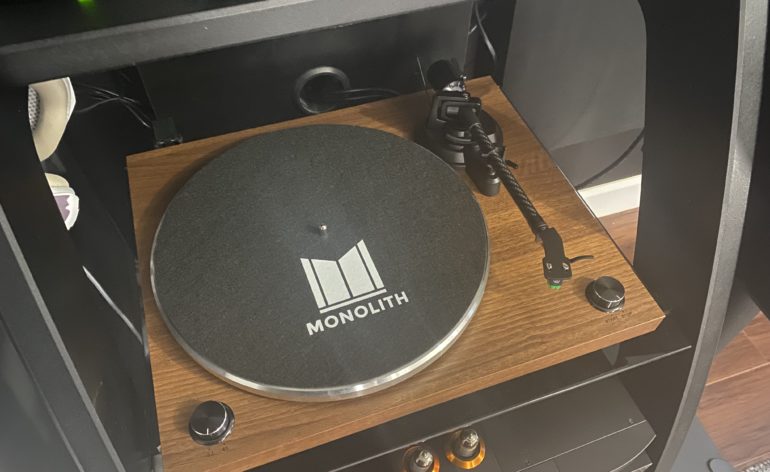

Hey Andrew,
Out of curiosity, did you try recording any of your records?
If you did, how was your experience?
Take it easy!
Hey. I did and it was pretty awesome, but I am still learning.
The turntable comes with its own USB cable so I hooked it up to my PC and used Audessy to do the recording.
The system recognized the turntable as my input device and I played a song to make sure I had it level matched properly.
I spun up the record and hit record and then just let it play through.
Once I was done, I did some quick editing to trim up the intro and outro so it sounded clean and then I saved it to a wav file so that I could convert it to whatever file I wanted.
The great thing about Audessy is that you can tinker with the file so if you want to reduce noise or normalize you can do that.
I am by no means a pro at it, but I figured that if I did enough songs, I would be able to squeeze the best out of every track.
Surprisingly, the recording is quite clean, even with my built in soundcard. I would think that if you were really serious, you could get some better gear, and really make it shine. But the turntable is not the weak link here.
I bought this turntable and was very disappointed. The speeds are off by a full 10% which is crazy. Sent it back for a refund
Hi Scott,
What app or device did you use to check yours? I used RPM on mine and I was almost bang on. At 10% you would be down 3.3RPM which I would think would be noticeable. I think you just got a lemon. I still think that this turntable is a lot of bang for the buck and I got a DC Evo as a present and it still stacks up against it really well.